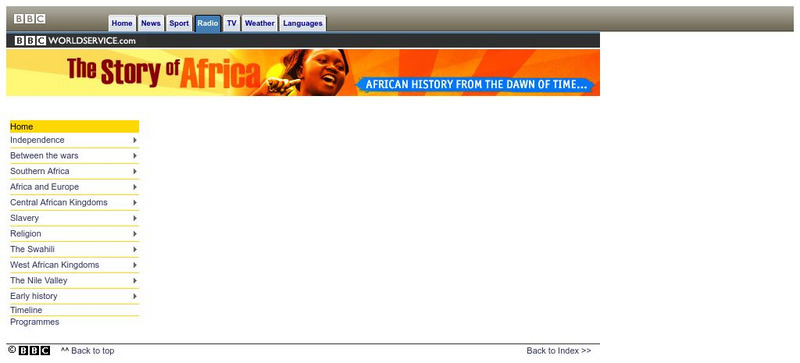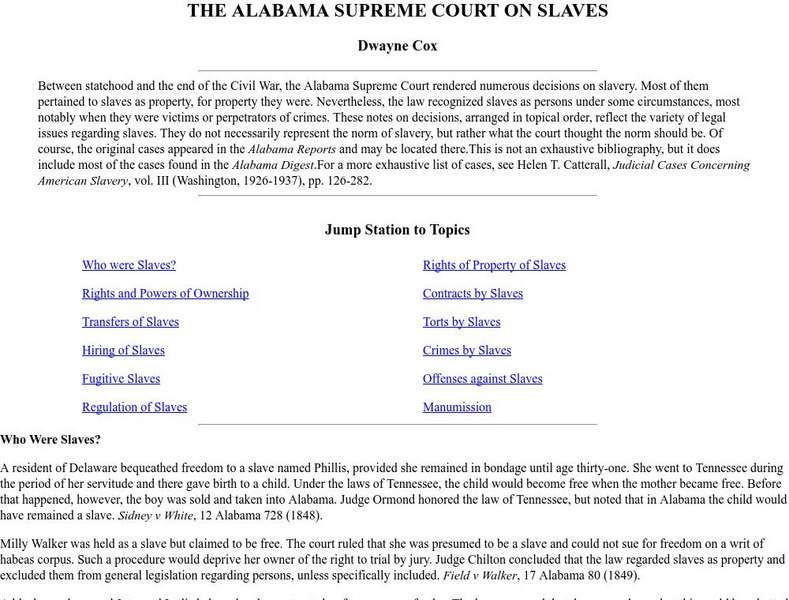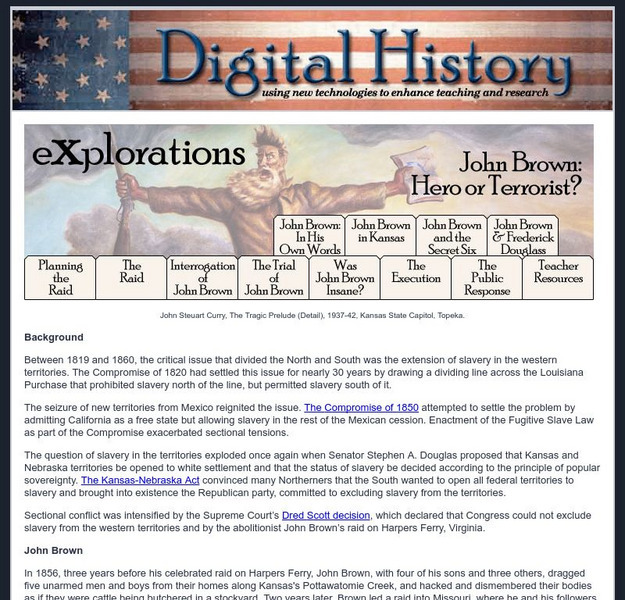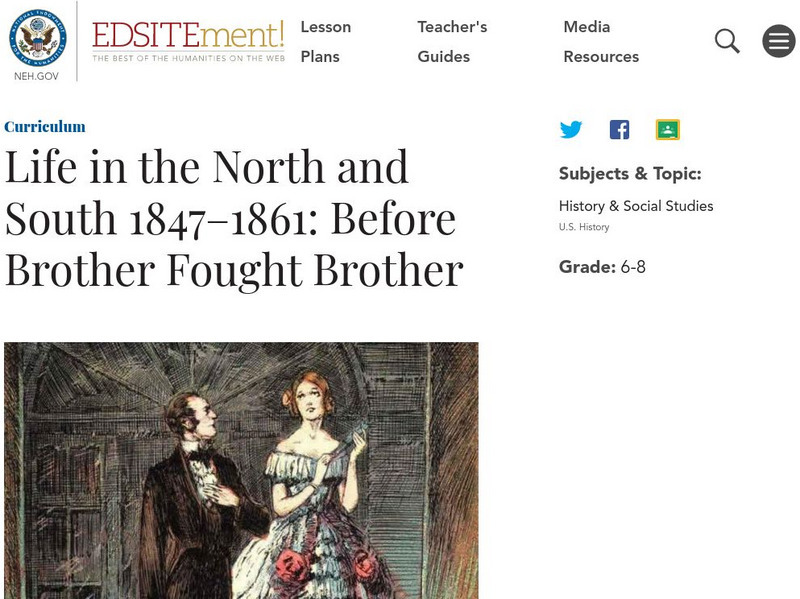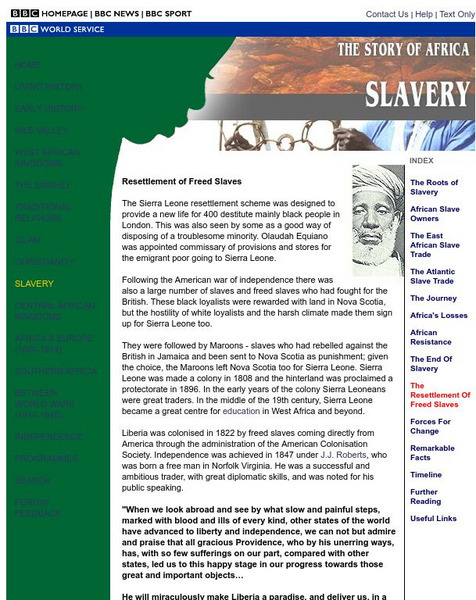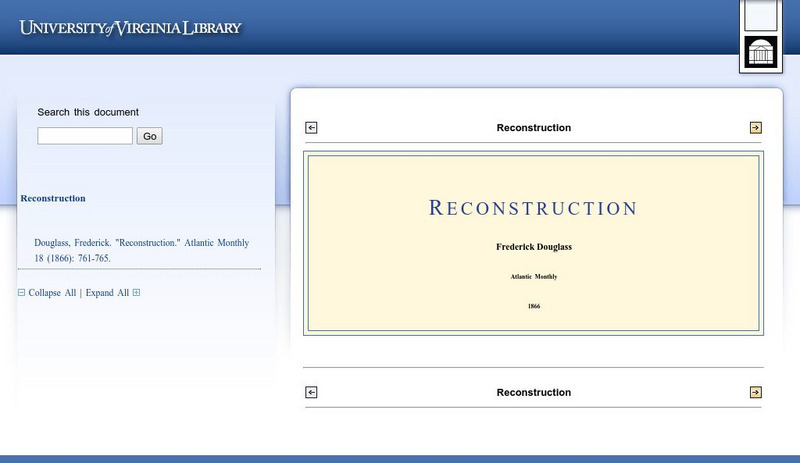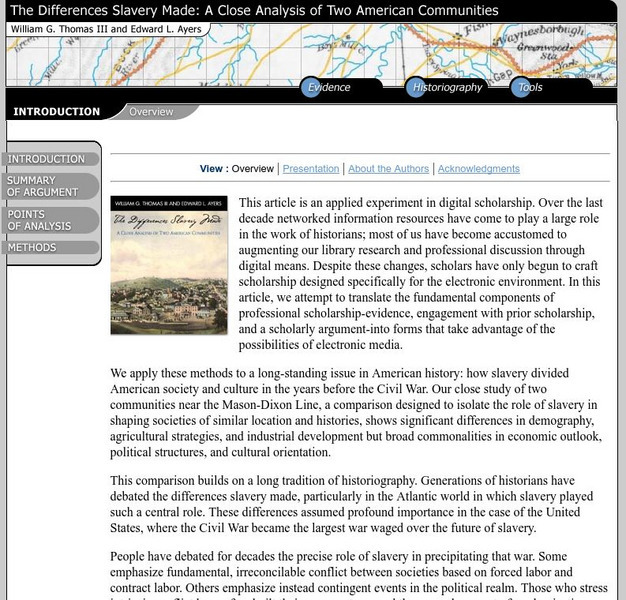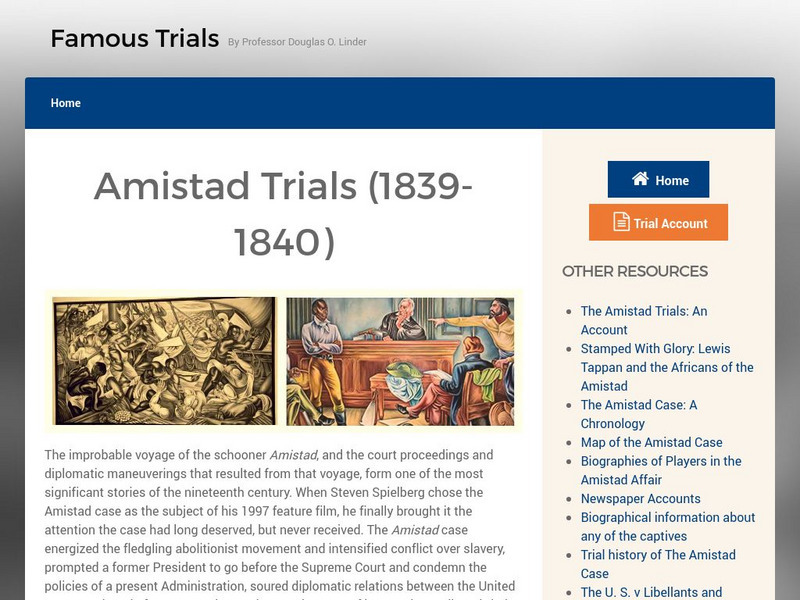Curated OER
Perspective on the Slave Narrative
Students work with the slave narrative as a resource for historical study and evaluate it as a work of literature; students then examine the narrative in the context of political controversy as an argument for abolition.
Curated OER
How Did You Get Here?
Students create a picture/poster or write a letter demonstrating their knowledge of why slavery was wrong. They describe what they think the travel was like for the Africans coming to America.
Curated OER
The Terrible Transformation: Freedom Denied
Students learn about the legal foundations for slavery and explore autobiographical writings of slaves. Students trace the development of laws that enforced the slave status of Africans and their descendants.
BBC
Bbc World Service:the Story of Africa
The history of Africa is documented from earliest times to the present. The menu bar divides it into time periods which then divide into sub-topics; also included is a visual timeline.
Auburn University
Auburn University: The Alabama Supreme Court on Slaves
This historical summary covers information on slaves during the mid-19th century in the following areas: Who were Slaves?, Rights and Powers of Ownership, Transfers of Slaves, Hiring of Slaves, Fugitive Slaves, Regulation of Slaves,...
Library of Congress
Loc: American Revolution
The history of the American Revolution is the focus of this article. Divided into topics and time periods, it makes understanding this historical time easier for students for follow.
Digital History
Digital History: Explorations: John Brown: Hero or Terrorist?
Comprehensive account explores John Brown, the Attack at Harper's Ferry, and his trial. You decide if he was a hero or a terrorist.
Cosmo Learning
Cosmo Learning: The Civil War and Reconstruction Era, 1845 1877
In this course Professor David Blight explores the causes, course, and consequences of the American Civil War, from the 1840s to 1877 through twenty-seven video lectures. The primary goal of the course is to understand the multiple...
Digital History
Digital History: Meaning of Freedom: Black and White Responses to End of Slavery
Confederate defeat and the end of slavery brought far-reaching changes in the lives of all Southerners. The destruction of slavery led inevitably to conflict between blacks seeking to breathe substantive meaning into their freedom by...
National Endowment for the Humanities
Neh: Edsit Ement: Life in North & South 1847 1861: Before Brother Fought Brother
The five lessons in this unit are designed to help students develop a foundation on which to understand the basic disagreements between North and South through the investigation of primary source documents, photographs, and census...
National Endowment for the Humanities
Neh: Edsit Ement: Lesson 2: People and Places in the North and South
Lesson explores the causes of the Civil War and the basic disagreements between North and South through the use of primary source documents, photographs, and census information. Includes two detailed student activities and resources for...
C3 Teachers
C3 Teachers: u.s. History Module: Did Lincoln Really Want to Free Slaves? [Pdf]
A comprehensive learning module on Abraham Lincoln that includes three supporting questions accompanied by formative tasks and primary source materials, followed by a summative performance task. Students examine the evolution of...
C3 Teachers
C3 Teachers: u.s. History Module: Is Freedom Free? [Pdf]
A comprehensive learning module on the impact of emancipation on ex-slaves that includes three supporting questions accompanied by formative tasks and primary source materials, followed by a summative performance task. Topics covered...
C3 Teachers
C3 Teachers: u.s. History Module: Did Charles Sumner Deserve It? [Pdf]
A comprehensive learning module on the abolitionist Charles Sumner that includes three supporting questions accompanied by formative tasks and primary source materials, followed by a summative performance task. Topics addressed include...
BBC
Bbc World Service: The Story of Africa: Slavery: Resettlement of Freed Slaves
Discusses the resettlement initiatives in the 1800s when freed slaves were sent to live in Sierra Leone and Liberia in Africa, and some of the difficulties they faced there.
National Humanities Center
National Humanities Center: Teacher Serve: The Varieties of Slave Labor
Daniel C. Littlefield, Professor of History at University of South Carolina, explores how plantation or slave labor differed according to location and period.
National Humanities Center
National Humanities Center: Teacher Serve: How to Read a Slave Narrative
This essay, written by English professor William L. Andrews, explores slave narratives and their influence in American literature in the late nineteenth century up to modern times.
PBS
Pbs Learning Media: Sapelo Island Culture
In this video segment from EGG: the arts show, learn about the Gullah/Geechee culture of Sapelo Island.
University of Virginia
The University of Virginia Library: Reconstruction, by Fredrick Douglass
A document on Reconstruction written by Fredrick Douglass. He argues particularly for voting rights for blacks as the most necessary step to avoid the kinds of state's rights conflicts that brought about the Civil War.
US National Archives
Nara: Treasures of Congress: Struggles Over Slavery the "Gag" Rule
This National Archives and Records Administration site contains John Quincy Adams' response to the "gag" rule in the House of Representatives, May 25, 1836, which restricted discussion about slavery in Congress . Also included are images...
University of Virginia
American Historical Review: The Differences Slavery Made
An in-depth scholarly investigation on the differences slavery made in the shaping of societies in the North and South by using two similar communities, one north and one south of the Mason-Dixon Line.
University of Missouri
Famous Trials: Amistad Trials
This site discusses the history and significance of the Amistad trial. Make sure to click on the "cont." link for more information on the history of the case.
University of Wisconsin
University of Wisconsin: Carl Schurz
A selection of German-American statesman and military leader Carl Schurz' writings on his life and "True Americanism".
PBS
Pbs Learning Media: Photo Gallery: Significant Abolitionists
Learn about the countless people who made important contributions to the abolitionist movement to end slavery. In this photo gallery from American Experience, explore some of these leaders and their vocations.





